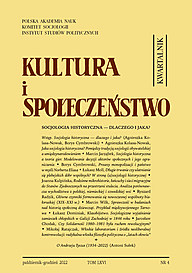RODZINNE MIKROHISTORIE, ŁAŃCUCHY I SIECI MIGRACYJNEDO STANÓW ZJEDNOCZONYCH NA PRZESTRZENI STULECIAANALIZA PORÓWNAWCZA WYCHODŹSTWAZ POLSKIEJ, NIEMIECKIEJ I SZWEDZKIEJ WSI
FAMILY MICROHISTORIES — CHAINS AND NETWORKS
IN MIGRATIONS TO THE UNITED STATES OVER THE CENTURIES. A COMPARATIVE ANALYSIS OF THE EXODUS
FROM RURAL POLAND, GERMANY AND SWEDEN
Author(s): Joanna KulpińskaSubject(s): Social history, History and theory of sociology, Migration Studies
Published by: Instytut Studiów Politycznych PAN
Keywords: United States; chain migrations; rural migrations; migration networks;
Summary/Abstract: The aim of this paper is to analyse the phenomenon of the formation of migration chains and networks from micro- (in relation to family migration microhistories) and meso-social (in the context of selected local communities) perspectives. With regard to migration flows from Europe to the US in the 19th and early 20th centuries, the sources for the analysis and reconstruction of migration chains and networks, and the scope of information that can be gathered from them, are compared. This embraces research conducted using the following: (1) data from the Ellis Island Archives — research by the article’s author, based on the analysis of ship passenger lists, on immigrants arriving in the United States from two neighbouring counties in Poland: Strzyżów and Rzeszów (over 4500 records); (2) information from the HESAUS database (emigration lists of the German duchy of Hesse-Cassel collected at the Hessisches Staatsarchiv in Marburg) analysed by Simone A. Wegge. on rural migrations from the historical area of the electorate of Hesse-Cassel in modern Germany in the 19th century to the USA (50,000 records); and (3) Swedish parish migration records examined by Anne-Marie Eurenius on individuals who migrated from the villages of the Halland region in southwestern Sweden to the United States in the late 19th century (1,500 records). The analysis was conducted using a comparative method, both synchronic and diachronic, addressing both the multigenerational perspective and migration trends in the different generations of migrants. The research process was based on the use of primary data.
Journal: Kultura i Społeczeństwo
- Issue Year: 66/2022
- Issue No: 4
- Page Range: 91-111
- Page Count: 21
- Language: Polish

